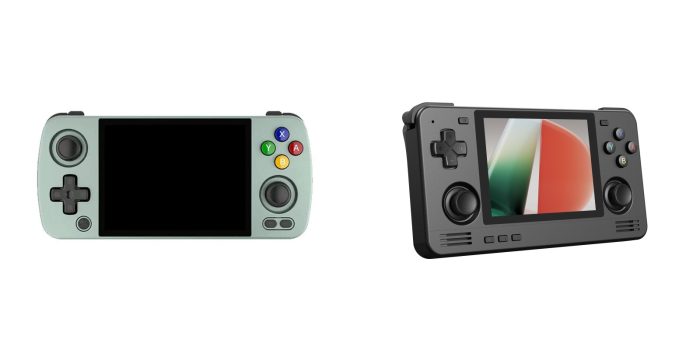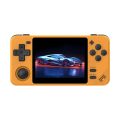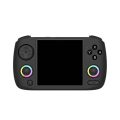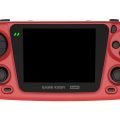Retro gaming handhelds have a certain appeal, especially for those of us who grew up during the golden era of gaming. Whether it’s about reliving childhood memories or simply enjoying classic titles, devices like the Anbernic RG405M and Retroid Pocket 2S stand out. Recently, I had the chance to get my hands on both devices, and today, I’ll share my thoughts on how they stack up.
Initial Impressions
Let me start by saying that both the RG405M and Pocket 2S have their merits, but each has unique strengths. The Anbernic RG405M immediately feels premium. The device has an aluminum body that screams quality. It’s heavier than the Retroid Pocket 2S, but not in an uncomfortable way. It feels solid, as if it could take a hit and keep going. In comparison, the Pocket 2S is lighter and feels a bit more plasticky, which doesn’t necessarily mean it’s cheap but just different in terms of build quality.
First Thing I Noticed: The Build
The first time I held the RG405M, it reminded me of the difference between using a plastic toy laptop versus a high-end aluminum MacBook. There’s something about the feel of cold metal that just makes you think, “This is durable.” For people who like sturdy gadgets, the RG405M is the clear winner in this department. It’s heavier than the Pocket 2S and even some modern smartphones, but it gives that “solid” feeling that I really appreciate.
That said, the Retroid Pocket 2S isn’t a bad piece of hardware by any means. It’s smaller and more lightweight, which means it’s easier to slip into a pocket or bag. However, because the analog sticks and triggers protrude, it’s less compact compared to the RG405M, which has recessed sticks and a flatter design. If you’re looking for something genuinely portable, the RG405M might suit your needs better. You won’t have to worry about your sticks getting caught on your bag or pocket.
Buttons and Controls
The first letdown with the RG405M was the buttons, particularly the shoulder buttons (R and L). They rattle. Yes, it’s a minor issue, but for someone like me who enjoys a clean build, this can be quite annoying. The buttons sometimes feel like they are not well-aligned. The d-pad, although functional, feels a bit loose, and it doesn’t have that satisfying clickiness you get with the Pocket 2S.
On the other hand, Retroid Pocket 2S feels well put together in this area. The buttons are responsive, and the d-pad works better, especially when playing games that require precise inputs. In games where you need fast and accurate control, the Pocket 2S has the upper hand.
However, RG405M has one advantage that can’t be overlooked: its analog sticks are excellent. They are accurate and feel good to use in 3D games, without the slight drift that cheaper sticks tend to suffer from over time.
Display Quality
Now, let’s talk about screens. The RG405M features a 4-inch display, which may not seem like much bigger than the 3.5-inch screen on the Pocket 2S, but in reality, that half-inch makes a world of difference. After playing on both, I found the RG405M to be a much more comfortable device for extended play sessions.
The RG405M’s screen is a touch larger, and it helps with visibility, especially when playing more detailed retro games. Text is easier to read, and overall, it feels like I’m less likely to strain my eyes after a few hours of play. The touchscreen aspect is handy, particularly for navigating menus and setting up emulators. However, it does suffer in terms of quality. Darker colors tend to have a blue-ish tint, and you’ll notice a bit of light bleed in darker scenes.
While the Pocket 2S has a smaller screen, its quality seems just a tad sharper and more vibrant. The colors pop more, especially reds and greens, and the contrast feels better overall. In pixel-perfect games, this sharper resolution is more noticeable. But, given how tiny the screen is, playing for long sessions can be tough on the eyes.
There’s another aspect to consider: brightness. The RG405M doesn’t get as bright as the Pocket 2S, so if you’re someone who plays outdoors or in well-lit areas, that might be a point in favor of Retroid’s device.
Sound Quality
In terms of audio, the Retroid Pocket 2S wins easily. It has front-facing speakers, while the RG405M places them on the bottom of the device. This might not sound like a big deal, but when the sound is directed towards you, it creates a more immersive experience. In contrast, the bottom-firing speakers on the RG405M tend to sound muffled, especially if you place the device on a surface while playing.
Performance and Emulation
Here’s where things get interesting. Both the RG405M and Pocket 2S are designed to handle retro games, and they do a decent job across most systems. For older platforms like Gameboy, NES, SNES, and PlayStation 1, both perform admirably, with no noticeable hiccups.
But when we start moving into heavier consoles like PlayStation 2 and Nintendo GameCube, there’s a clear difference. The Anbernic RG405M handles these more demanding systems better, especially when it comes to titles that require more graphical power. For example, I was genuinely surprised by how well GTA San Andreas performed on the RG405M. The game ran at a smooth 25-30 FPS, something I didn’t expect from a handheld of this price range.
On the Retroid Pocket 2S, however, GameCube and PS2 emulation is more hit or miss. Some games run okay, but others are downright unplayable due to slow frame rates or audio issues. If you’re looking for a device that can tackle these more recent retro systems, the RG405M is the better option.
Software and User Experience
One major gripe I have with the Anbernic RG405M is its operating system. Out of the box, the default OS comes with a weird sharpening filter that just ruins the visuals. Luckily, I replaced the stock OS with Gamma OS, which significantly improved performance and visuals, though it’s not without its quirks.
The Pocket 2S doesn’t have this issue. It’s ready to go with solid software from the start. However, if you’re into tweaking and optimizing your device, you might still want to install custom firmware on either device to get the best experience possible.
Battery Life
Battery life on both devices is what you’d expect for handhelds with this level of power. You’ll get about 4-5 hours of playtime with the RG405M, depending on what you’re playing, and slightly more on the Pocket 2S. The aluminum body of the RG405M does a good job of dissipating heat, so I found that it runs cooler during long play sessions compared to the Pocket 2S, which can get a bit warm.
Final Verdict: Which One to Keep?
So, which one is better? If I had to choose one, I’d go with the Anbernic RG405M, despite its quirks. Its larger screen and better emulation of newer systems make it more versatile. Sure, it has some rattly buttons and a less-than-perfect display in terms of contrast, but the premium feel and performance in demanding games are worth it.
The Retroid Pocket 2S is still a great device, especially for those who value portability and don’t mind a slightly smaller screen. It also has better software support out of the box, and its display is sharper in many cases. But for me, the RG405M‘s combination of performance, build quality, and compact design puts it ahead, even with its few drawbacks.
What do you think? Let me know your thoughts, and let’s talk more about retro gaming handhelds!





